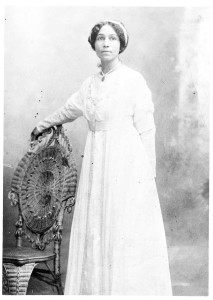 Years ago I drove up a long hilly road and an equally long, bumpy driveway in Austerlitz, New York, to visit “Steepletop”, the home of twentieth century American poet Edna St. Vincent Millay. One of the plants that grew on the Steepletop property, in Millay’s time and now, is the “poet’s daffodil” or Narcissus poeticus. It seemed very fitting.
Years ago I drove up a long hilly road and an equally long, bumpy driveway in Austerlitz, New York, to visit “Steepletop”, the home of twentieth century American poet Edna St. Vincent Millay. One of the plants that grew on the Steepletop property, in Millay’s time and now, is the “poet’s daffodil” or Narcissus poeticus. It seemed very fitting.
This past week, as I researched the life and work of twentieth century poet/gardener Anne Spencer, I saw a picture of a Narcissus poeticus that grows in her Lynchburg, Virginia garden. It seemed equally fitting there.
The two women poets, one Black and the other white, were contemporaries. The long-lived Spencer was born in 1882 and died in 1975. Millay was ten years younger, born in 1892, and died relatively young in 1950. Both were published poets, renowned for cultivating circles of equally talented and celebrated friends. The two women also shared a passion for gardening and did much of their writing in dedicated spaces adjacent to their gardens. Millay was better known in her time, but Spencer also gained fame, becoming only the second Black poet to be included in the Norton Anthology of Poetry.
I first found out about Anne Spencer’s garden through my membership in the Garden Conservancy, an organization dedicated to preserving notable American gardens. The Conservancy continues to provide assistance in the restoration of Spencer’s landscape, which she started around 1903 and tended for most of her life. It is one of only two Conservancy projects in Virginia. The other is the Pavilion Gardens at the University of Virginia in Charlottesville.
Though a unique set of family circumstances prevented Anne Spencer from learning to read until she was eleven years old, she developed a robust imaginative and creative interior life and eventually excelled as a scholar. After her marriage at age 21, she began work on her garden as well as her 20-year career as a librarian at a segregated high school. She turned to political activism, helping to found the Lynchburg chapter of the NAACP. In the midst of that eventful life, she also became a published a poet. Though she lived in Virginia, she was close to the leading thinkers, writers and artists of the Harlem Renaissance, the flowering of arts and culture that flourished in Harlem during the 1920’s. Langston Hughes, W.E.B. Dubois, Zora Neale Hurston, writer/civil rights activist James Weldon Johnson and many other luminaries were among the guests welcomed to her Lynchburg home.
The garden that Anne Spencer created was full of flowers, fruits and greenery. Formal hedges and walkways surrounded a small reflecting pool ornamented with a gift from Dubois–a fountain sculpted in the form of the head of an African woman. Other features included blue-painted containers planted with flowering bulbs and annuals. Wisteria wound its way up a pergola and grapes grew on a dedicated arbor. Spencer loved roses and grew varieties that included ‘Spanish Beauty’, also known as ‘Madame Gregoire Staechelin’, a large-flowered climber with pink blooms.
Spencer’s writing cottage adjoins the garden. Built by her husband, Edward, the building was christened “Edankraal’, a name that combined the first two letters of Edward’s name with the first two letters of Anne’s, coupled with the Afrikaans word “kraal”, which means “enclosure”. Like other structures in the garden, Edankraal, was painted robin’s egg blue.
The garden was one of Spencer’s great loves and a major theme in her poetry. I especially like the passion and intimacy of “Lines to A Nasturtium,” which begins,
“Flame-Flower, Day-Torch, Mauna Loa,
I saw a daring bee, today, pause, and soar
Into your flaming heart;…”
It is no surprise that the garden also made its way into the title of a posthumously published book, Time’s Unfading Garden, which includes Spencer’s poetry and details of her life.
The garden reached its peak at the end of the 1930’s, but was tended by Spencer for many years afterwards. Eventually though, energy wanes for even the most committed gardener, and by the end of the poet’s long life, the garden had begun to decline. In 1983, eight years after her death, Richmond’s Hillside Garden Club began the first phase of restoration work. Fortunately, the garden was well documented in photographs and lived on in the memory of Spencer family members. A second phase of restoration began in 2007, when garden features like the pool and pergola were reconstructed with the goal of capturing the spirit of the 1930’s garden. The restored landscape includes many of Spencer’s original perennials and roses, as well as other plantings appropriate to the age and situation of the garden. Author and gardener Jane Baber
White documented the restoration effort in a 2011 book, Lessons learned from a Poet’s Garden: The Restoration of the Historic Garden of Harlem Renaissance Poet Anne Spencer.
The next time I am in Virginia, I will visit the Anne Spencer House and Garden Museum, which is open to the public. The property was designated a Virginia Historic Landmark in 1976. It has also been awarded Historic Landmark status by the Association for the Study for Afro-American Life and History, and included on the National Register of Historic Places.
